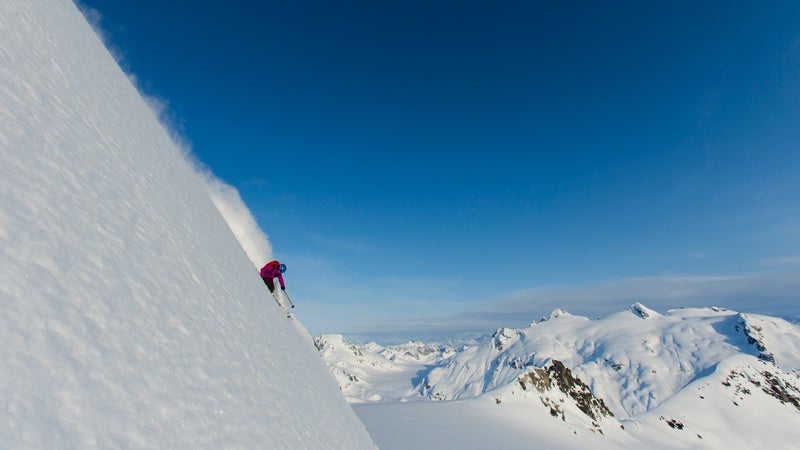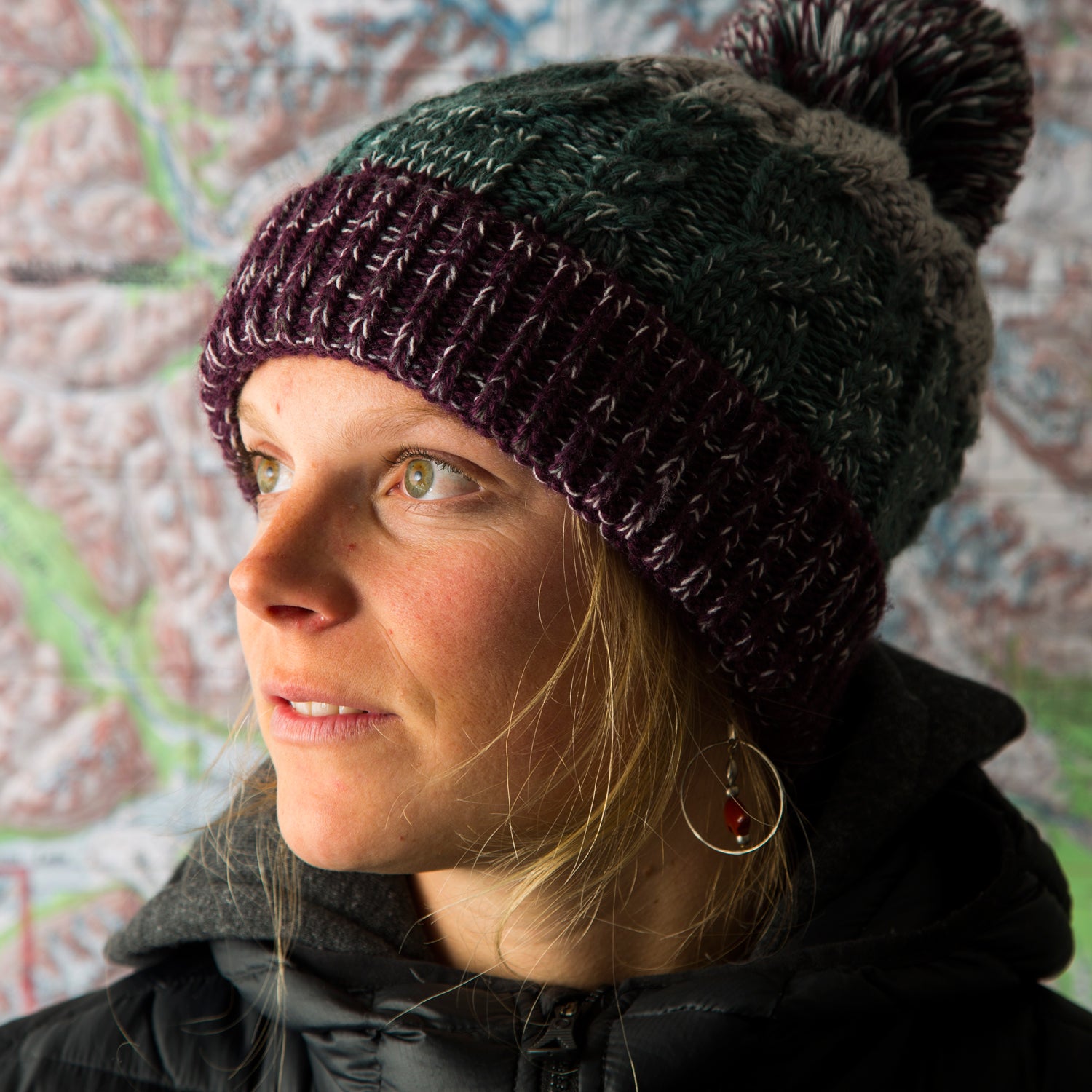Last winter, Angel Collinson was deep in AlaskaŌĆÖs Neacola Mountains, a jagged subrange of the Aleutian Mountains about 120 miles southwest of Anchorage, in a zone that rarely sees skiers or climbers due to its rugged remoteness. For four weeks, Collinson lived out of a glorified tent city, population 13ŌĆöall athletes and filmmakersŌĆöwhoŌĆÖd been dropped there by bush plane to film , the latest ski flick from Teton Gravity Research.
On good days, Collinson and fellow skiers Ian McIntosh and Sage Cattabriga-Alosa would ride towering spines in glowing sunlight for the cameras. When the weather didnŌĆÖt cooperate, theyŌĆÖd pass the time playing dice games in the tent.┬Ā
On the last day of the trip, with the weather and snow conditions prime for filming, the TGR team settled on skiing a zone the skiers called the Magic Kingdom. It was a toothy, shark fin of a peak with only a couple of high-consequence skiable lines that dropped over a blind rollover from the summit. ŌĆ£I knew I was capable of skiing it,ŌĆØ says Collinson, whoŌĆÖs 25. ŌĆ£But it would be at the height of anything IŌĆÖd ever done.ŌĆØ
ŌĆ£Her approach to the mountains is calm and calculated.ŌĆØ
During a mellow warm-up run that morning, Collinson felt offŌĆömentally tired, a little slow to react. The weeks of high intensity skiing had set in, and she knew instinctually that it wasnŌĆÖt the day to try something big. ŌĆ£It was one of those situations where I didnŌĆÖt want to talk myself into it,ŌĆØ she says. ŌĆ£Sometimes thereŌĆÖs just that gut feeling you have to listen to and I did that day. I was worried IŌĆÖd regret not stepping up to the plate, but instead I discovered this deep sense of trust in myself.ŌĆØ
Bowing out of what could be the filmŌĆÖs best shot wasnŌĆÖt an easy decision. TGR is one of the premier action sports video companies in the world and the king of ski porn, and has launched the career of many budding pro skiers like Todd Ligare┬Āand Ian McIntosh. Inclusion in the studioŌĆÖs films can secure an athleteŌĆÖs reputation and livelihood and help attract mega sponsorship deals. That day in Alaska, Collinson told the filmmakers she wasnŌĆÖt up for the challenge and instead skied an easier line on another face. Opting out took the courage of a proŌĆöa skier with less self-confidence might have gone for it in spite of the dangerŌĆöand cemented CollinsonŌĆÖs status as an A-lister with TGR.
ŌĆ£Her approach to the mountains is calm and calculated,ŌĆØ says TGR co-founder Todd Jones. ŌĆ£SheŌĆÖs not out there forcing it. When the mountains speak, she listens.ŌĆØ
It turned out that Collinson didnŌĆÖt even need that final day to turn in a staggering performance in Paradise Waits. She already had enough footage in the can from the previous weeks, flashing elevator-shaft steeps and airing cliffs with graceful fierceness, to create what the Ski Journal ŌĆ£the burliestŌĆöand most entertainingŌĆöfemale film segment of all time.ŌĆØ Her footage ended up earning her the coveted closing segment in Paradise Waits, marking the first time a woman has been selected for a TGR finale. The year prior, Collinson also broke barriers with the first female opening segment of a TGR film, in 2014ŌĆÖs . In fact, until Collinson showed up on the scene three years ago, the studio hadnŌĆÖt featured a woman in a film in years.
That segment for Best Female Performance and Best Line (the first time a woman has won that, too) at the Powder Awards, at the International Freeski Film Festival, and she was named Freeskier │Š▓╣▓Ą▓╣│·Š▒▓į▒ŌĆÖs for 2015.┬Ā
All that attentionŌĆöthe film segments, the awards, the media interviewsŌĆöstill feels a little foreign, Collinson says. ŌĆ£ItŌĆÖs nice to be recognized for something youŌĆÖre good at, but I honestly donŌĆÖt like being in the limelight.ŌĆØ
Collinson would certainly be entitled to an ego after the past couple of years sheŌĆÖs had: ski movie stardom, major awards, lucrative endorsement offers. But, according to those closest to her, thatŌĆÖs not her style. ŌĆ£For Angel, it almost works the other way. The more success she has, the more humble she seems to get,ŌĆØ says her brother, 23-year-old fellow pro skier John Collinson. ŌĆ£She has always been, and I think always will be, grounded. Now sheŌĆÖs just learning how to deal with the stresses that come with success.ŌĆØ

Collinson and her brother were bred into skiing. They grew up sharing a bunkbed in a closet-sized room in employee housing at the base of Snowbird, Utah, where their dad, Jimmy, was a ski patroller and snow-safety director for over 30 years. They were one of few families living in the dorm-style apartments.
CollinsonŌĆÖs mom, Deb, homeschooled her two children (and a couple other ski kids as well) inside a tiny schoolroom in the canyon. Each summer the family would pile into a 1979 blue Ford Econoline van and travel the west, climbing mountains like Whitney, Shasta, and Hood, and backpack for weeks on end. The Collinson kids took strongly to the outdoors. As a teenager, Angel, whoŌĆÖs two years older than her brother, was a world-class junior ski racer. At 17, John became the youngest person to climb the seven summits.┬Ā
ŌĆ£I┬Āknow I can use my voice in meaningful ways. But sometimes I want to be that 16-year-old nobody with my headphones on doing Snowbird tram laps and not talking to anybody.ŌĆØ
When Collinson was 18, she narrowly missed the cut for the U.S. Ski Team, and as a result decided to pull the plug on gates. She earned a full academic scholarship at the University of Utah in Salt Lake City with the intention of pursuing a double major in environmental studies and philosophy. Shortly after enrolling, she signed up for her first big-mountain freeskiing contest.
In her┬Ārookie year on the Freeskiing World Tour, in 2010, at age 19, Collinson won the overall womenŌĆÖs title. She won again in 2011.┬ĀIn 2012┬Āshe┬Ādecided, as a sophomore, to put college on hold so that she could really focus on skiing. She doubled up and competed on both the American Freeskiing World Tour and the European Freeride World Tour, earning second place overall on both tours. She was known for her consistency in steep terrainŌĆösheŌĆÖd pick a line nobody else would even see, then plunge in at top speed with utter confidence as the slope dropped away beneath her.
Her results were strong enough to catch the eyes of TGRŌĆÖs filmmakers and, in 2013, while waiting in the tram line at Snowbird, she got the call inviting her to join the crew for her first major┬Āforay in AlaskaŌĆöto┬ĀKnik Glacier, a remote part of the Chugach Mountains. She has since been featured in three TGR films.┬Ā
Rather than focus on promoting herself on social media, which has become an essential part of making a living as a pro athlete, Collinson would rather that her ski styleŌĆöcomposed, calculated, fastŌĆöspeaks for itself. ŌĆ£Skiing has always been my freedom and my happy place. Now all of a sudden, people are paying attention to it,ŌĆØ she says. ŌĆ£WhatŌĆÖs that quote? ŌĆśWith great power comes great responsibility.ŌĆÖ I know I can use my voice in meaningful ways. But sometimes I want to be that 16-year-old nobody with my headphones on doing Snowbird tram laps and not talking to anybody.ŌĆØ
But while Collinson has the attention, she intends to use it. Applying her notoriety to environmental causes is her latest focus. SheŌĆÖs teamed up with the non-profit organization to lobby for climate change policy on the streets of Washington, D.C. She penned a November 2015 op-ed for ║┌┴Ž│į╣Ž═° about the impact of UtahŌĆÖs power plants on the stateŌĆÖs air quality. She also works with the Sierra Club on various climate change and clean air projects.┬Ā
This winter, Collinson says her primary goal is simply to film another quality segment with TGR. Eventually, she wants to go back to school and focus on environmental policy. But for now, sheŌĆÖs working to improve on the slopes. ŌĆ£When I see my footage, I always see the things I could have done better,ŌĆØ she says. ŌĆ£I always feel like I have more in the tank.ŌĆØ┬Ā


